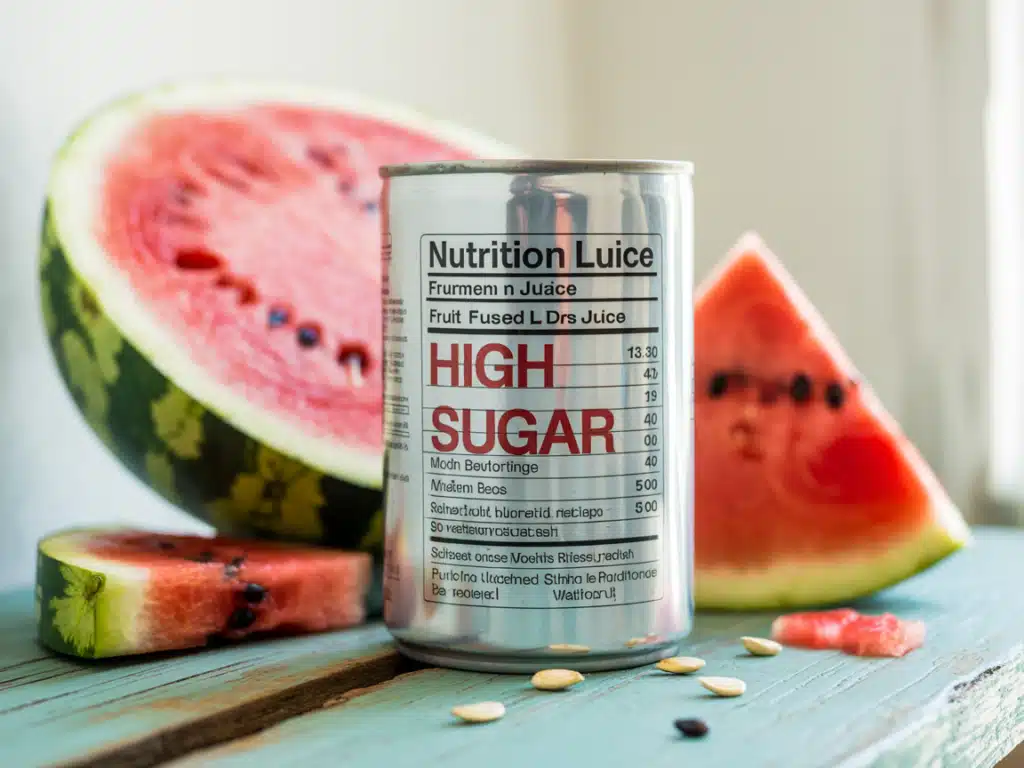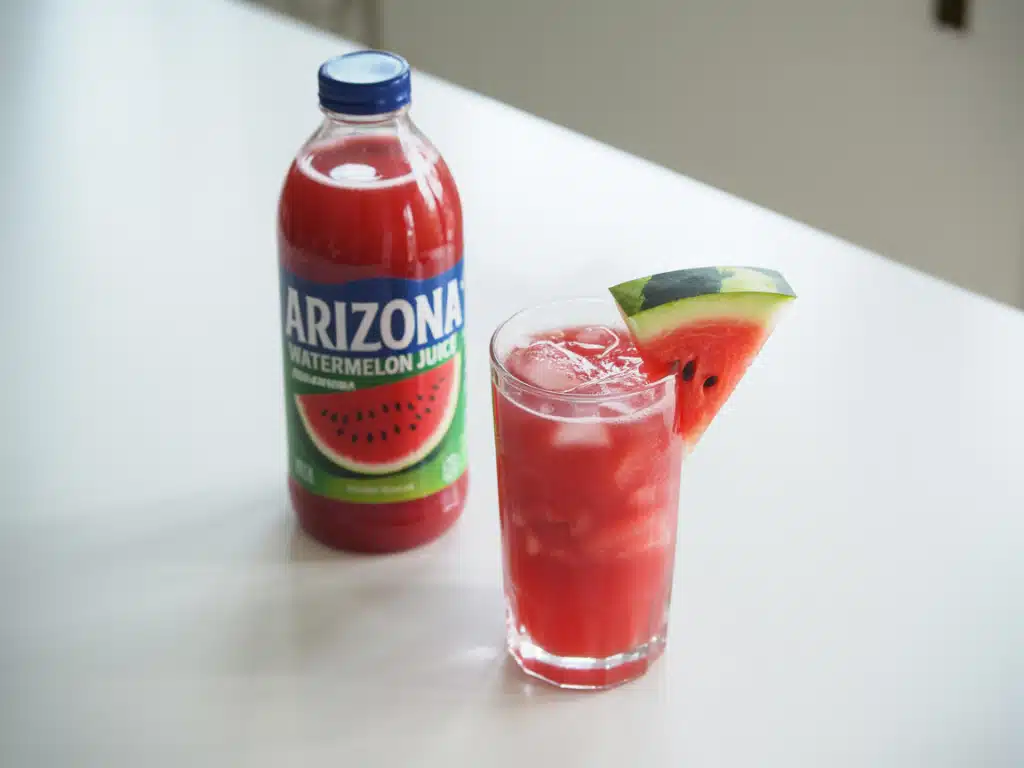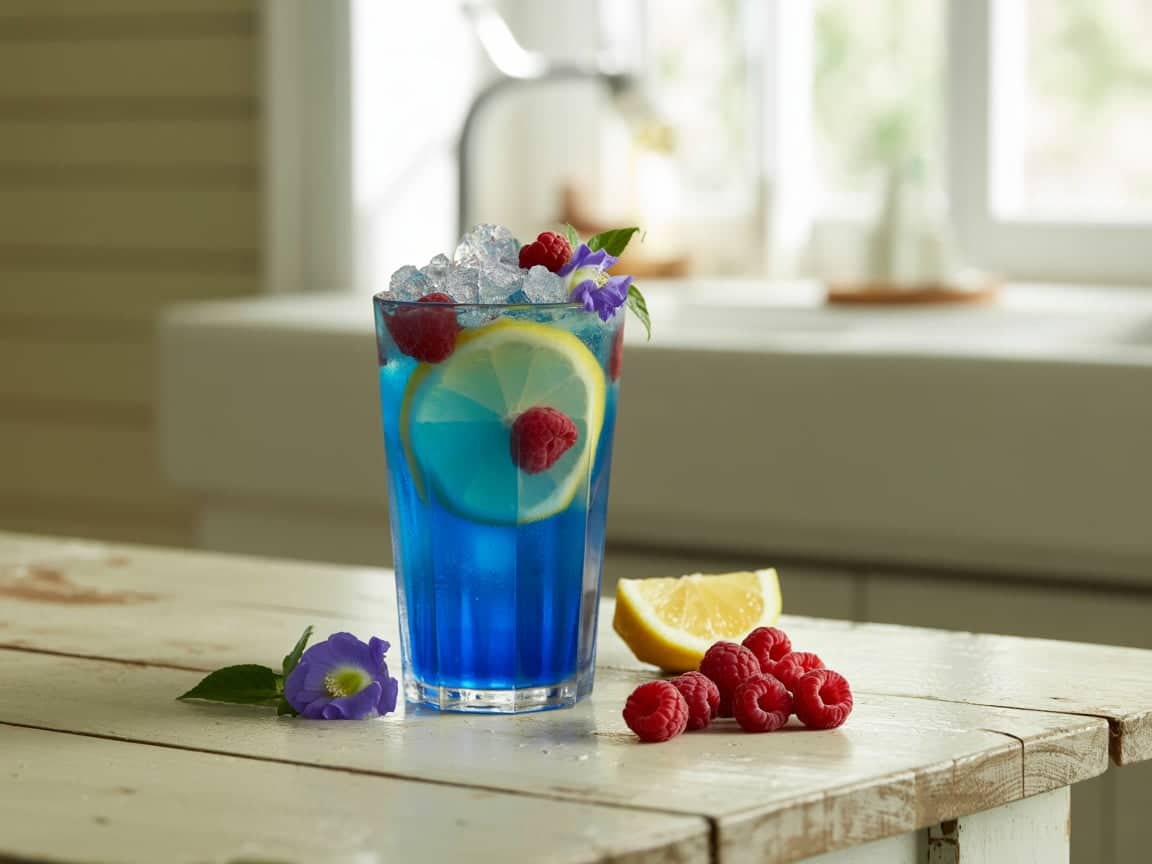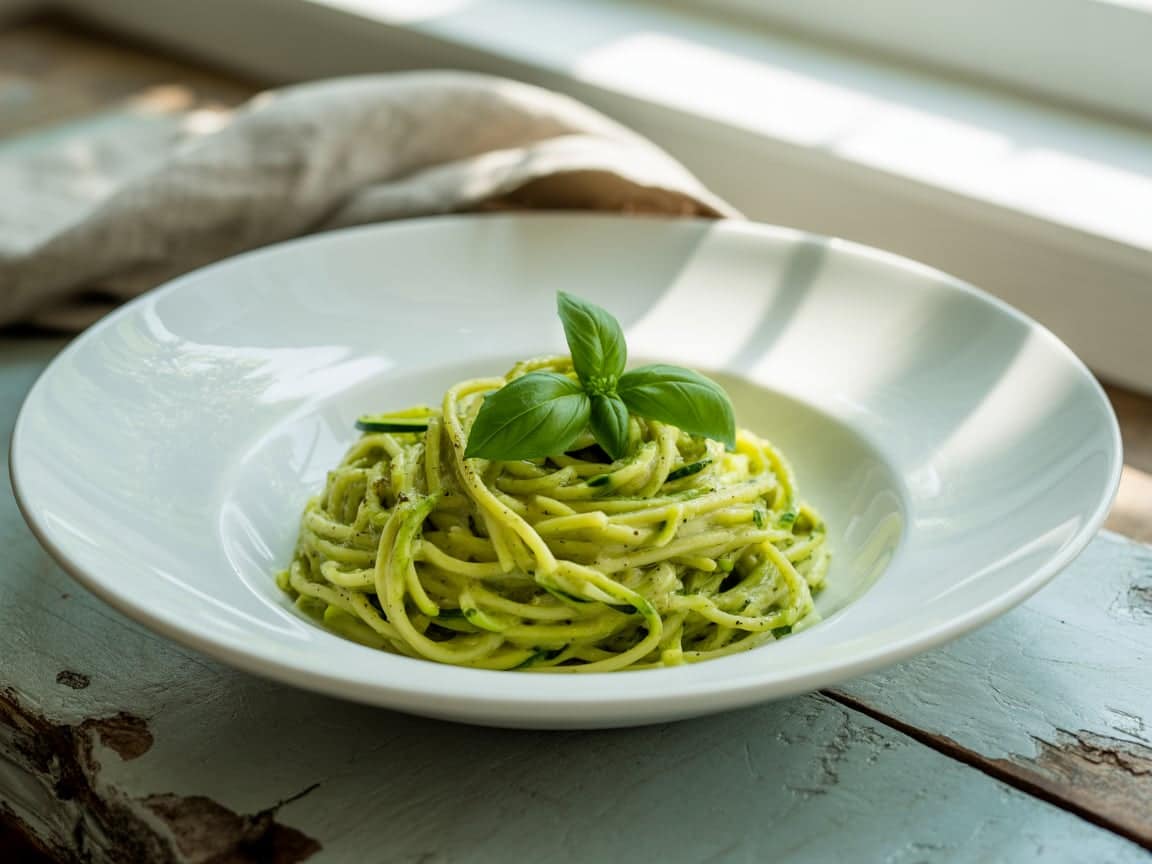Arizona Watermelon Fruit Juice first caught my eye on a blazing summer afternoon—one of those days where even the breeze feels warm and you’re just craving something refreshing. As the mom behind Cozy Bites Recipes, my life is deeply rooted in food, flavor, and memories. From my grandmother’s cozy kitchen to now creating recipes for my own family, I’ve always believed food should do more than nourish—it should spark joy.
That first sip of Arizona’s sweet, chilled watermelon juice instantly transported me back to lazy summer picnics and big slices of juicy watermelon under the sun. But as someone who’s committed to sharing comforting recipes made with love and real ingredients, I had to ask myself—what’s really inside this can of watermelon bliss?
In this deep-dive, I’ll take you through everything you need to know about Arizona Watermelon Fruit Juice. From its ingredients and sugar content to how it compares with real fruit juice and homemade alternatives, this article gives you all the juicy details. Let’s dive in!
Discover great ideas like ABC Fruit Juice Recipe if you’re curious about other fruit-based drinks with real benefits.
Table of Contents
What Is Arizona Watermelon Fruit Juice?
The Story Behind Arizona Beverages
Arizona Beverages USA isn’t just famous for its 99-cent price tag—it’s known for creating iconic flavors like Mucho Mango, Green Tea with Honey, and yes, Watermelon Fruit Juice. Launched in the early ’90s, this New York-based company built its empire on flavor-packed teas and juice blends that appeal to budget-savvy consumers.
Over time, Arizona’s colorful tall cans became more than just drinks—they became a staple of convenience store culture. And among the vibrant line-up, Arizona Watermelon Fruit Juice stands out for its vibrant red can, nostalgic fruit-cart vibe, and smooth watermelon taste.
A Deep Dive Into Arizona Watermelon Fruit Juice Flavor
Let’s get this out of the way—Arizona Watermelon Fruit Juice doesn’t taste like the fresh watermelon you’d slice open at a summer BBQ. It’s sweet, syrupy, and more like a watermelon-flavored punch than freshly pressed juice. But that’s part of the charm.
This drink blends watermelon essence with other fruit flavors to create a candy-like beverage that’s especially popular among teens and young adults. The ingredients? Water, high fructose corn syrup, pear juice from concentrate, watermelon juice from concentrate, and “natural flavors.”
But here’s where the curiosity sets in: Does Arizona Watermelon Fruit Juice actually contain real watermelon—or is it just a cleverly branded sweet drink in disguise? That’s exactly what we’ll uncover in the next section.
Looking for inspiration? Try Chia Seeds Smoothie as a refreshing, nutrient-dense alternative to sugary drinks.
Ingredients Breakdown and Nutritional Label

Does Arizona Watermelon Have Real Watermelon?
The bold red label might scream fresh fruit vibes, but the truth behind Arizona Watermelon Fruit Juice is a bit more complex. Yes, it includes watermelon juice—from concentrate. That distinction matters. “From concentrate” means the juice has been processed, dehydrated, stored, and later reconstituted—very different from freshly pressed juice.
Surprisingly, Arizona Watermelon Fruit Juice doesn’t even list watermelon as its primary juice. That spot goes to pear juice concentrate, a cheaper filler often used to bulk up fruit drinks without altering the sweetness too much. So while watermelon is present, it’s far from the main ingredient—and certainly not the juicy centerpiece the packaging suggests.
The rest of the ingredients include:
- Filtered water
- High fructose corn syrup
- Pear juice from concentrate
- Watermelon juice from concentrate
- Citric acid (for tartness)
- Natural flavors
- Red 40 (artificial coloring)
- Ascorbic acid (Vitamin C preservative)
In short, real watermelon is in the mix, but it’s not front and center—and it’s heavily processed. The flavor you taste is a combination of artificial and natural components engineered for consistency, not freshness.
How Much Sugar Is in Arizona Watermelon Juice?
This is where things get sticky—literally.
A single 23 fl oz can of Arizona Watermelon contains a whopping 72 grams of sugar. That’s almost 18 teaspoons of sugar in one serving. To put that into perspective:
| Beverage | Sugar Content (per 23 oz) |
|---|---|
| Arizona Watermelon Juice | 72g |
| Coca-Cola (same volume) | 65g |
| Fresh Watermelon Juice | 30-35g (natural sugars) |
| Homemade Fruit Infused Water | 0g |
While the label on Arizona Watermelon Fruit Juice boasts “100% natural flavors,” the reality is more sugary than sweet. The primary sweetener used is high fructose corn syrup (HFCS)—a processed sugar associated with weight gain, insulin resistance, and other health issues when consumed in excess.
So, is Arizona Watermelon Fruit Juice a healthy option? Not really. Its sugar content actually surpasses that of many popular soft drinks and sweetened iced teas. While an occasional can might be fine, relying on it as your go-to hydration source isn’t the best idea. If you’re looking for real refreshment, a fresh watermelon smoothie or infused water might be a smarter choice.
Don’t miss our Zobo Drink Recipe if you want a flavorful, antioxidant-rich alternative that uses real hibiscus and spices.
Health Benefits vs Risks
Is Arizona Watermelon Fruit Juice Good for You?
Let’s get honest—Arizona Watermelon Fruit Juice might quench your thirst on a hot day, but calling it “healthy” would be a stretch. While the label does highlight Vitamin C and real juice content, the truth lies in the bigger picture.
Here’s what you get in every can:
- Hydration from water and juice
- A small dose of Vitamin C
- A refreshing, fruity flavor
But here’s the catch:
- Zero fiber (unlike fresh watermelon)
- High fructose corn syrup as the primary sweetener
- Empty calories—roughly 270 per 23 oz can
- Blood sugar spike due to its high glycemic index
So, is Arizona Watermelon Fruit Juice good for you? If hydration is your main concern, then yes—it’ll keep you refreshed. But if you’re looking to nourish your body with real nutrients, manage your weight, or cut down on sugar, this probably isn’t your best option.
That said, there’s nothing wrong with enjoying Arizona Watermelon Fruit Juice occasionally—especially when served ice-cold on a sunny day with friends. Just don’t mistake it for a nutrient-dense beverage like fresh juice or a smoothie packed with whole fruits, vegetables, and seeds.
Check out Liver Flush Juice Recipe if you’re looking for a truly detoxifying, health-boosting beverage made from natural, whole ingredients.
Artificial Sweeteners and Flavorings Explained
Though Arizona Watermelon Fruit Juice doesn’t contain zero-calorie artificial sweeteners like aspartame or sucralose, it does include “natural flavors”, a term that can cover a wide range of lab-derived flavor compounds.
Here’s what’s inside the flavor profile:
- Natural Flavors – This could be derived from fruit, but processed with solvents or additives
- Red 40 – A synthetic dye commonly used in candy and sodas
- Citric Acid – Adds tanginess and acts as a preservative
While all these ingredients are approved by the FDA, frequent consumption can still raise health questions—especially among kids and people sensitive to additives.
In contrast, real watermelon offers:
- Natural hydration
- Antioxidants like lycopene
- Electrolytes (potassium & magnesium)
- Fiber (which helps slow sugar absorption)
So, while Arizona’s version gives a short-term sugar rush, real fruit wins for long-term benefits.
Discover great ideas like Purple Peel Recipe, another vibrant homemade option with powerful antioxidants and no artificial junk.
Comparing Arizona Watermelon Fruit Juice to Other Fruit Juices

Arizona vs Fresh Cold-Pressed Watermelon Juice
This comparison is where things get real. While Arizona Watermelon Fruit Juice may taste like summer, fresh cold-pressed juice delivers the actual health benefits.
| Feature | Arizona Watermelon Juice | Fresh Watermelon Juice |
|---|---|---|
| Real Fruit Content | Juice from concentrate (low %) | 100% real fruit |
| Sugar | 72g per 23 oz (added sugars) | 30–35g per 23 oz (natural sugars) |
| Fiber | 0g | 1g+ |
| Artificial Additives | Yes (Red 40, natural flavors, HFCS) | No |
| Hydration Benefits | Moderate (due to sugars) | Excellent (electrolytes & water-rich) |
| Calories | ~270 per can | ~140 per glass |
Verdict: Fresh juice wins on every count—hydration, nutrient density, and clean ingredients. Arizona’s version might satisfy a craving, but if your goal is nourishment, fresh is best.
Arizona vs Other Arizona Flavors (Mucho Mango, Green Tea)
Arizona Beverages is known for bold flavors and a budget-friendly price point. So how does the watermelon variety stack up next to its siblings?
Let’s take a look:
| Flavor | Sugar (per 23 oz) | Calories | Key Additives |
|---|---|---|---|
| Watermelon | 72g | ~270 | Red 40, HFCS, pear juice |
| Mucho Mango | 63g | ~250 | Yellow 6, mango flavor |
| Green Tea | 54g | ~200 | Honey, ginseng, natural tea |
Arizona Green Tea stands out slightly better because of its inclusion of ginseng and green tea extract, which add potential antioxidants. But overall, the line is high in sugar across the board, making none of them particularly healthy.
However, Arizona Watermelon Fruit Juice remains a fan-favorite for its nostalgic flavor and visual appeal.
Looking for inspiration? Try Pink Salt Recipe, a great low-sugar DIY mix to pair with healthier homemade drinks.
Arizona Watermelon Fruit Juice and Sugar Content
Fructose, Cane Sugar, and Syrup Impact
The sweet taste of Arizona Watermelon Fruit Juice isn’t just from fruit—it’s largely from high fructose corn syrup (HFCS), one of the most controversial sweeteners on the market. While HFCS is cheaper than cane sugar, it’s processed and has been linked to:
- Increased risk of obesity
- Higher triglyceride levels
- Insulin resistance
- Fatty liver in excessive consumption
Each 23 oz can delivers 72g of sugar, which is about 144% of the daily recommended intake for added sugar, according to the American Heart Association.
So, what types of sugar are inside?
- High fructose corn syrup (HFCS) – Main sweetener
- Pear juice concentrate – Adds natural sugar
- Watermelon juice concentrate – Minor natural sugar
Though pear and watermelon sound innocent, once concentrated, they become sugar-dense and lose fiber. This means your body absorbs the sugar quickly, leading to energy crashes and potential fat storage.
How It Fits Into a Low-Sugar or Keto Diet
Short answer: It doesn’t.
Let’s break it down for common diet plans:
| Diet Type | Can You Drink Arizona Watermelon? | Why / Why Not |
|---|---|---|
| Low-Sugar Diet | ❌ Not Recommended | 72g sugar is excessive |
| Keto Diet | ❌ Avoid Completely | Too many carbs, high glycemic load |
| Balanced Diet | ⚠️ Only in moderation | High sugar; pair with protein/fiber |
| Diabetic Diet | ❌ Not suitable | Spikes blood sugar |
Even one can can throw you off track if you’re watching carbs or trying to reduce insulin spikes. If you enjoy Arizona Watermelon but want to stay on the healthy side, consider watering it down or using it as a flavor base in mocktails mixed with sparkling water and lime.
Check out Natural Mounjaro Recipe, a great alternative for managing cravings without the sugar crash.
Arizona Juice’s Marketing vs Reality
Packaging vs What’s Really Inside
The Arizona Watermelon Fruit Juice can is a masterpiece of design—eye-catching, nostalgic, and refreshing at first glance. Bright red and green with classic fruit illustrations, it suggests something natural, cool, and juicy. But when you flip the can and read the label, the story starts to unravel.
The can promotes:
- “100% Natural Flavors”
- “Fruit Juice Cocktail”
- “Vitamin C Fortified”
- Images of fresh watermelon slices
But the facts show:
- Only a small percentage of watermelon juice
- Heavy use of high fructose corn syrup
- Artificial coloring (Red 40) for that vibrant hue
- No dietary fiber, antioxidants, or meaningful nutrients
Arizona banks on emotional marketing—evoking memories of sweet summer days and fruit stands. While there’s nothing illegal about this, it’s misleading for consumers who assume they’re buying a healthy watermelon-based juice.
The label may say “fruit juice cocktail,” but that term legally allows the inclusion of more sugar than juice—and this one definitely delivers on sugar.
Does the Label Mislead Health-Conscious Consumers?
Yes—and here’s how:
- Natural flavors can mean lab-extracted compounds that originated from a natural source but were chemically altered.
- The Vitamin C boost sounds impressive, but it’s only ~20% of your daily value—added mostly as a preservative (ascorbic acid).
- The term “juice cocktail” implies a mix of fruits, but pear juice dominates over watermelon.
So while technically accurate, the branding walks a fine line between truth and illusion. It’s a drink designed to look healthy and fresh without actually delivering those benefits.
Learn more about Bariatric Seed Recipe—a nutrient-dense homemade drink alternative perfect for health-conscious sippers.
When and How to Drink Arizona Watermelon Fruit Juice
Best Times to Consume for Hydration or Energy
Despite its high sugar content, there are times when drinking Arizona Watermelon Fruit Juice might actually make sense—if timing and purpose are considered.
Here’s when it fits:
- Post-workout energy boost: After intense cardio or weight training, your muscles crave quick sugars to replenish glycogen stores. Arizona’s high sugar count makes it a quick source of energy—just pair it with protein for balance.
- Hot summer afternoons: It works as a refreshing beverage when served over ice, especially during outdoor events or BBQs.
- Low-blood sugar situations: For people with hypoglycemia, a half-can of Arizona can raise blood sugar quickly—but it must be monitored.
When you should avoid it:
- Early mornings: Spiking blood sugar first thing can lead to energy crashes later.
- Late at night: Sugar before bed may disrupt sleep and digestion.
- With heavy meals: It adds unnecessary sugar and calories to already calorie-rich meals.
So, while it’s not a daily drink, in moderation and at the right time, it can be enjoyed responsibly.
Combining With Meals, Smoothies, or Mocktails
Want to make Arizona Watermelon a little healthier? Try using it as an ingredient, not the whole drink. Here are some ideas:
| Method | How to Use It | Why It Works |
|---|---|---|
| Mocktail Base | Mix with sparkling water, lime, and mint | Dilutes sugar, adds freshness |
| Smoothie Flavor Boost | Use 1/4 cup in a fruit smoothie with banana and Greek yogurt | Adds flavor without overpowering nutrients |
| Fruit Popsicles | Freeze with chunks of real watermelon and strawberries | Kid-friendly treat with better texture |
| Salad Dressing Base | Reduce on stovetop with balsamic for a tangy-sweet glaze | Adds unique watermelon twist to savory dishes |
These methods let you enjoy the flavor without taking in the full sugar load. They’re perfect for households with kids or anyone trying to cut back without cutting out.
Don’t miss our Semolina Pudding Recipes for pairing your drinks with a satisfying, semi-sweet dish.
Healthy Alternatives to Arizona Watermelon Fruit Juice
Homemade Watermelon Juice Recipes
If you love the refreshing taste of watermelon but want to skip the artificial additives, sugar overload, and questionable labeling—homemade watermelon juice is your best bet.
Here’s a simple and clean recipe straight from a real-food kitchen:
Homemade Watermelon Juice (2 servings)
Ingredients:
- 3 cups cubed seedless watermelon (chilled)
- 1 tbsp lime juice (optional)
- A few mint leaves
- Ice cubes (optional)
Instructions:
- Add watermelon cubes to a blender.
- Squeeze in lime juice and toss in mint leaves.
- Blend until smooth.
- Pour through a fine mesh strainer if you prefer pulp-free juice.
- Serve over ice and enjoy!
Benefits:
- Natural sugars only
- High water content (hydrating)
- Vitamin C, lycopene, and potassium
- No additives, no dyes
This version tastes like summer in a glass—and it’s refreshing, clean, and kid-friendly too.
Other Hydrating Drinks Like Chia Smoothies
Watermelon isn’t the only way to quench your thirst. Drinks that combine hydration with nutrients are ideal if you’re cutting back on sugary options.
Here are three fantastic alternatives:
| Drink | Why It’s Better | Try This Recipe |
|---|---|---|
| Chia Seed Smoothie | High in omega-3s, fiber, protein | Try Chia Seeds Smoothie |
| Zobo (Hibiscus) Drink | Loaded with antioxidants, vitamin C, and tart flavor | Explore Zobo Drink |
| Cucumber Mint Water | Ultra-low calorie, naturally detoxifying | Mix sliced cucumbers, lemon, and mint in chilled water |
These drinks hydrate without spiking blood sugar, and some—like chia smoothies—can even help with digestion and sustained energy.
Check out Natural Zepbound Recipe for another naturally functional beverage idea loaded with plant-based power.
Where to Buy Arizona Watermelon Fruit Juice and Final Verdict
Online and Local Retailers
You’ve probably seen Arizona Watermelon Fruit Juice at your local gas station, grocery store, or dollar shop. Its wide availability and eye-catching design make it one of Arizona’s most popular flavors.
Here’s where you can buy it:
| Retailer | Availability | Notes |
|---|---|---|
| Walmart | In-store & online | Often sold in bulk at discount prices |
| Target | In select locations | May offer singles or 12-packs |
| Amazon | Yes | Look for multi-can deals with fast shipping |
| Convenience Stores | Almost always | Grab-and-go favorite |
| Gas Stations (7-Eleven) | Frequently stocked | Priced around $0.99 to $1.25 per can |
Tip: Buying in bulk online can reduce per-can cost—but check sugar intake if you’re ordering large quantities.
Is It Worth Your Money for Taste and Health (Arizona Watermelon Fruit Juice)?
Let’s break it down into categories that matter most to consumers:
1. Taste
Absolutely yes. Arizona Watermelon is flavorful, nostalgic, and cooling. It’s sweet, fruity, and easy to love—especially for those who grew up sipping Arizona teas.
2. Health Value
Not really. It’s heavy on high fructose corn syrup, artificial coloring, and excess sugar. The tiny bit of watermelon juice isn’t enough to provide meaningful nutrition.
3. Price
Excellent. It’s hard to beat Arizona’s legendary 99-cent pricing, especially for a 23 oz can. From a value-for-volume standpoint, it wins big.
4. Practicality
Great for road trips, BBQs, and cooling down—but not ideal for daily hydration or kids’ lunchboxes unless diluted.
Final Take:
Arizona Watermelon Fruit Juice is a flavorful budget-friendly option, best enjoyed occasionally and in moderation. If you’re seeking a daily go-to for hydration or wellness, opt for fresh homemade juices, infused waters, or nutrient-rich smoothies instead.
Don’t miss our Brazilian Mounjaro Recipe if you’re looking for something naturally sweet, nourishing, and rooted in whole-food ingredients.
FAQs – Arizona Watermelon Fruit Juice
Is Arizona Watermelon good for you?
Arizona Watermelon may be delicious, but it’s not considered healthy. With 72 grams of sugar per can, high fructose corn syrup as the main sweetener, and minimal real fruit juice, it’s more of a sweet treat than a nutritious beverage. While it contains some Vitamin C, it lacks fiber, antioxidants, and other key nutrients found in fresh fruit juice.
Does Arizona Watermelon have real watermelon?
Yes—but in a limited, processed form. Arizona Watermelon Juice contains watermelon juice from concentrate, which means it’s reconstituted from dehydrated juice. Additionally, pear juice from concentrate appears earlier on the label, suggesting watermelon is not the main fruit ingredient despite its name and branding.
How much sugar is in Arizona Watermelon juice?
A standard 23 oz can of Arizona Watermelon contains 72 grams of sugar—which equals about 18 teaspoons. That’s significantly higher than most sodas or fruit juices and well above the recommended daily intake for both men and women. The sugar is primarily added via high fructose corn syrup.
How healthy is Arizona juice?
In general, Arizona juices are high in sugar and low in actual fruit content. While some varieties like Green Tea contain herbal extracts or Vitamin C, most Arizona drinks—including the watermelon flavor—offer little in terms of fiber, antioxidants, or beneficial nutrients. They’re enjoyable occasionally but don’t qualify as a health drink.




